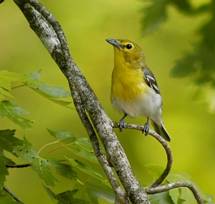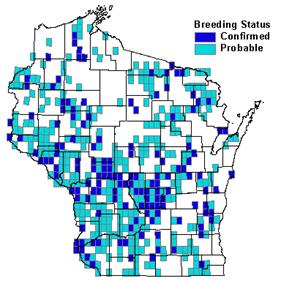Photo by Dennis Malueg


Status/Protection
- Global Rank: G5 Key to global and state ranks
- State Rank: S4B
- WBCI Priority: PIF
Population Information
Federal BBS information can be obtained at http://www.mbr-pwrc.usgs.gov/bbs/bbs.html by clicking on Trend Estimates and selecting the species in question. All estimates are for 1966-2005.
- Federal Breeding Bird Survey: significant increase
- Federal Breeding Bird Survey (WI): significant increase
- Federal Breeding Bird Survey (BCR 23): significant increase
- Federal Breeding Bird Survey (BCR 12): non-significant increase
- Chequamegon National Forest Bird Survey (NRRI):- non-significant decline (1992-2005)
- WSO Checklist Project: significant increase (1983-2007)
Life History
- Breeding Range: Throughout eastern U.S. west to the Great Plains (Rodewald and James 1996).
- Breeding Habitat: Oak, Bottomland Hardwoods, Central Hardwoods, Scrub Oak, and Northern Hardwood.
- Nest: Small, rounded cup suspended by rim from forked branch.
- Nesting Dates: Eggs: mid-May to early July (Robbins 1991).
- Foraging: Foliage glean, hover glean; slow and methodical during foraging.
- Migrant Status: Neotropical migrant.
- Habitat use during Migration: Generally deciduous and mixed deciduous-coniferous forests, frequently along forest edge.
- Arrival Dates: Early to late May.
- Departure Dates: Late August to late September.
- Winter Range: Southern Mexico, Central America, and down to western Colombia and northern Venezuela.
- Winter Habitat: Not well understood, but known from a wide variety of habitats including forest edge, second-growth woodlands, swamps, and thorny scrub.
Habitat Selection
The Yellow-throated Vireo occurs in mature deciduous woods, particularly oak-dominated woodlands (Robbins 1991). In Wisconsin Mossman (1988) found this species to be common in mature, open southern floodplain forests. Breeding territories in Wisconsin generally have larger trees, more white oaks, and fewer shrubs than surrounding microhabitats (Ambuel and Temple 1983). Bond (1957) found Yellow-throated Vireos associated less with dense, moist stands of sugar maple and more with forests and edges of intermediate maturity and moisture in southern Wisconsin. Although it is attracted to large tracts of forest, the Yellow-throated Vireo is more common along forest edges and streams than is the Red-eyed Vireo (Rodewald and James 1996). It is replaced by the Blue-headed Vireo in the coniferous forests of the northern counties (Mossman and Lange 1982).
Habitat Availability
Although not common anywhere in the state, Yellow-throated Vireo has been documented in every county in Wisconsin (Robbins 1991). The large deciduous forest tracts that are preferred by this species occur in southwest, central, and northern Wisconsin (Robbins 1991, Volkert 1992). However, Yellow-throated Vireo is largely restricted to upland sites dominated by oak woodlands and mature floodplain forests – both of which become less common as you go north in Wisconsin. The Yellow-throated Vireo is considered an area-sensitive species (Rodewald and James 1996). Robbins (1979) found that forests smaller than 100 hectares (247 acres) in the Northeast supported significantly fewer Yellow-throated Vireos. Relatively few nesting opportunities exist in predominantly agricultural or urban areas where forests are highly fragmented.
Population Concerns
Yellow-throated Vireo populations are increasing in Wisconsin and throughout much of their range (Rodewald and James 1996, Sauer et al. 2005). However, a study by Askins et al. (1990) found a sharp decrease in Yellow-throated Vireo populations specifically in the fragmented forests of the eastern United States. During the six-year period (1995-2000) of the Wisconsin Breeding Bird Atlas, observers recorded breeding evidence in more than half of the surveyed quads (Lesher 2006).
Forest maturation after logging likely has been beneficial to the Yellow-throated Vireo. The termination of pesticide applications against beetle vectors of Dutch elm disease also may have contributed to the success of this species. In some regions, the change to more selective logging practices has created more abundant forest openings attractive to this species (Rodewald and James 1996). Morton (1992) ranked this species as highly vulnerable to tropical deforestation.
Recommended Management
While typically associated with forest edge, this species may require large blocks of intact forest interior habitat or high percentages of regional forest cover to breed successfully (Rodewald and James 1996). Management efforts should focus on conserving large tracts of oak dominated woodland and floodplain forest south of the tension zone. Excessive forest fragmentation makes areas unsuitable for this species and exposes nests to Brown-headed Cowbird parasitism. Conservation and management strategies for this species should be focused on the following Wisconsin ecological landscapes: Central Sand Plains, Central Sand Hills, Southwest Savanna, Western Coulees and Ridges, and Western Prairie. Kettle Moraine State Forest is considered an important area for breeding Yellow-throated Vireos (Volkert 1992).
Research Needs
Research is needed regarding habitat preferences, sensitivity to tropical forest logging and fragmentation, foraging behavior, and diet on the wintering grounds. Within its breeding range, research is needed into the optimal mixture of mature forest and forest edge habitat for this species, and how such habitat preferences may vary regionally (Rodewald and James 1996).
Information Sources
- Birds of Forested Landscapes, Cornell Lab of Ornithology: www.birds.cornell.edu/bfl/speciesaccts/yetvir.html
- Chequamegon National Forest Bird Survey (NRRI) species account: http://www.nrri.umn.edu/mnbirds/accounts/YTVIa2.htm
- Nicolet Northern Forest Bird survey map http://www.uwgb.edu/birds/nnf/species/YTVI.htm
- North American Breeding Bird Survey: http://www.npwrc.usgs.gov
- Temple S.A., J.R. Cary, and R. Rolley. 1997. Wisconsin Birds: A Seasonal and Geographical Guide. Wisconsin Society of Ornithology and Wisconsin Department of Natural Resources, Madison, WI.
- Wisconsin Breeding Bird Atlas: www.uwgb.edu/birds/wbba/
References
- Ambuel, B. and S.A. Temple. 1983. Area-dependent changes in the bird communities and vegetation of southern Wisconsin forests. Ecology 64: 1057-1068.
- Askins, R.A., J.F. Lynch, and R. Greenberg. 1990. Population declines in migratory birds in eastern North America. Curr. Ornithol. No. 7.
- Bond, R.R. 1957. Ecological distribution of breeding birds in the upland forest of southern Wisconsin. Ecol. Monogr. 27(4): 351-384.
- Lesher, F. 2006. Yellow-throated Vireo. In The Wisconsin Breeding Bird Atlas (R. Howe, N. Cutright, B. Harriman, eds.) The University of Wisconsin Press: Madison, WI.
- Morton, E.S. 1992. What do we know about the future of migrant landbirds. Pp. 579-589 In: Hagan, J.M. III, and D.W. Johnston [eds.]. Ecology and conservation of Neotropical migrant landbirds. Smithson. Inst. Press, Washington, D.C.
Mossman, M.J., and K.I. Lange. 1982. Breeding birds of the Baraboo Hills, Wisconsin: Their history, distribution and ecology. Wis. Dep. Nat. Resour. and Wis. Soc. Ornithol., Madison. - Mossman, M.J. 1988. Birds of Southern Wisconsin floodplain forests. Passenger Pigeon 50(4) 321-337.
- Robbins, C.S. 1979. Effects of forest fragmentation on breeding bird populations. Pp. 198-213 In: Management of north central and northeastern forests for nongame birds (R. M. DeGraff and K. E. Evans, eds.). U.S. For. Serv., Gen. Tech. Rept. NC-51.
- Robbins, S.D., Jr. 1991. Wisconsin birdlife: Population and distribution past and present. Madison, WI: Univ. Wisconsin Press.
- Rodewald, P.G., and R.D. James. 1996. Yellow-throated Vireo. The Birds of North America, No. 247 (A. Poole and F. Gill, eds.). The Birds of North America, Inc., Philadelphia, PA.
- Sauer, J.R., J.E. Hines, and J. Fallon. 2005. The North American Breeding Bird Survey, Results and Analysis 1966 - 2005. Version 6.2.2006. USGS Patuxent Wildlife ResearchCenter, Laurel, MD.
- Volkert, W.K. 1992. Survey of the birds of the northern Kettle Moraine region. Passenger Pigeon 54: 137-145.
Contact Information
- Compiler: Tom Klubertanz, tklubert@uwc.edu
- Editors: Rick Anderson, Rick.Anderson@co.clark.wi.us | Kim Kreitinger, K.Kreitinger@gmail.com
